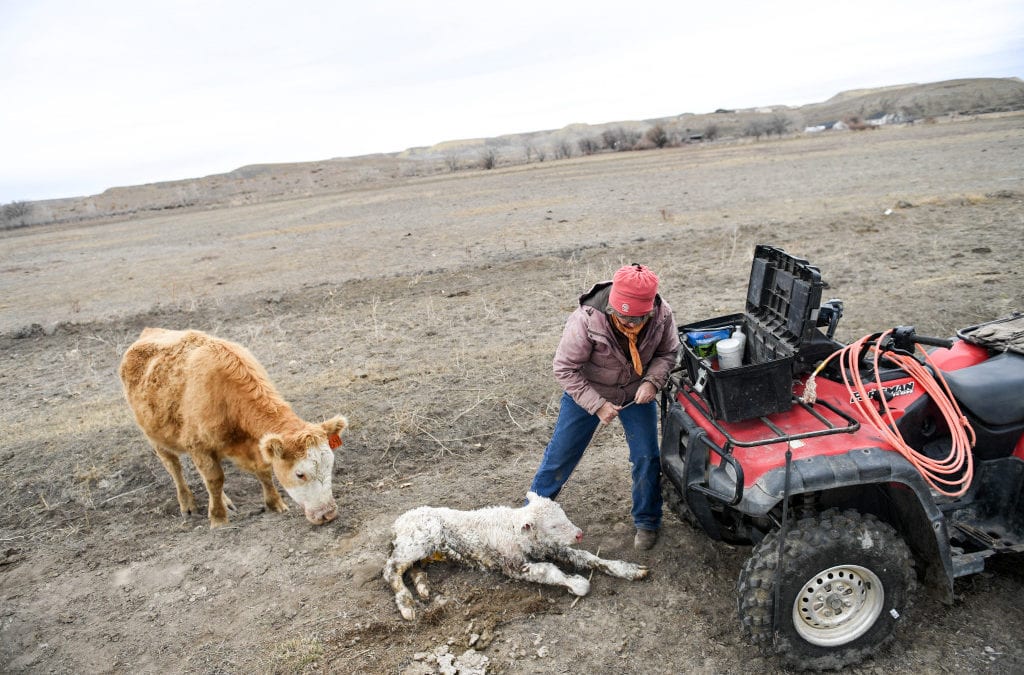Rancher Janie VanWinkle has a gnawing feeling that when she’s ready to sign a deal this summer to sell her calves, she could see the price she gets drop by as much as 50%. Lee Leachman is looking at discounting the bulls he sells for breeding by about 20%.
Denver chef Bo Porytko, who runs Misfit Snackbar in Denver, went looking for beef at the Restaurant Depot last week and found mostly empty shelves at the warehouse.
“It was like people were immediately doing the toilet paper thing,” Porytko said.
From the start of the beef supply chain to the end, COVID-19 has created kinks that, if not straightened out, could lead to limited selection in grocery stores, higher prices for restaurants and consumers and some Colorado ranchers shutting their gates for good.
The biggest obstacle is in the middle, where the cattle are sent to feedlots for about 150 days and then to slaughter. Big plants in Colorado and across the country that typically process thousands of cattle a day have shut down temporarily or greatly scaled back as the novel coronavirus has swept through the workforce. Thousands of workers nationwide have been stricken and at least 20 have died.
Seven workers at the JBS plant in Greeley have died from the coronavirus. The Cargill meatpacking plant in Fort Morgan reduced operations in April after an employee died from COVID-19 and others became sick.
“The first thing that has to happen is we have to get the workers healthy and make sure that they’re safe,” VanWinkle said. “But I am telling you, I have big concerns about the future of ranching in Colorado and other places as well.”
The last couple of years, the VanWinkles got $1.55 to $1.60 per pound for their calves, or around $1,000 for a 6- to 8-month-old animal delivered to the feedlot. This year, VanWinkle fears the per-calf selling price could drop by as much as half.
Feedlots are filling with cattle waiting to be processed while meat-packing plants run at reduced levels because of virus outbreaks.
Beef plants across the country on average are running at about 65% of their capacity, said Keith Belk, head of the Department of Animal Sciences at Colorado State University. He said there are signs the companies are getting a handle on ways to protect workers and will start increasing production.
“That said, I don’t see them coming back to full capacity for a long time,” said Belk, who is worried about the fallout for the feedlot owners and associated businesses, such as trucking companies and veterinarians.
As the plants further separate work spaces to stop the spread of the coronavirus, they can’t bring in all of their employees, he added. And a number of people aren’t at work because they’re ill or considered at risk for getting ill, Belk said.
President Trump signed an executive order in late April to keep meat processing plants open by declaring them “critical infrastructure.”
Consumers are likely to find it harder to find certain kinds of cuts of meat at certain points, and that will vary by region, Belk said.
“When you have a supply chain shock like this it’s going to have a huge impact. People in the industry are saying the last time there was anything like this in the United States was World War II,” Belk said.
Kate Greenberg, the Colorado agriculture commissioner, doesn’t anticipate widespread beef shortages in the state. Colorado ranks fourth in the nation for fresh and frozen beef exports and for the number of cattle processed, annually producing about 2.85 million cattle valued at $3 billion. In Colorado, there are millions of pounds of meat in cold storage, she said.
However, Greenberg noted that stores are starting to limit the amount of meat people can buy.
Amanda Demo, general manager of Western Daughters Butcher Shoppe, cuts beef before opening on Wednesday, March 26, 2020. The shop, located in the Highlands, is working with local farmers and ranchers who’ve been selling to restaurants and are now scrambling to find new customers, including through individual customers. The novel coronavirus pandemic has interrupted meat supply chains.
A King Soopers spokeswoman said the chain has temporary limits on the number of packages of fresh ground beef, poultry and pork customers can buy.
“But from all we can tell from all the work we’ve been doing and conversations we’ve been having with partners across the country, it is very much parallel to the toilet paper deal,” Greenberg said. “People see weaknesses and vulnerabilities in the system. They feel a sense of anxiety that they need to buy much of that product, and then you see empty shelves, which is a reinforcing cycle.”
Shoppers likely will see higher prices in the stores, but the U.S. Department of Agriculture recently said the increases should be slight, from 1-2%. A pound of lean ground beef averaged just under $5 in the region that includes Colorado at the end of April, according to the USDA. It was just under $4 a pound in late December.
Greenberg said what’s happening in Colorado is less severe than in other states that are big producers of other types of animals. Pigs, chickens and turkeys in other states are being euthanized when they outgrow their spaces and the meatpacking plants are backed up.
It’s different with cattle.
“With cattle, our ranchers are able to keep them on the ranch for longer. They have much greater margins in terms of time,” Greenberg said.
It’s more a question of how much it’s going to cost ranchers to keep animals longer than they intended.
Ranchers, small processing operations and the state agriculture department, through its Colorado Proud program, are trying new ways to directly connect producers with consumers.
“I think those kinds of plants are going to be really successful during this period of time,” Belk said. “But it’s not enough volume to fix the issue. There’s just not enough of them.”
At Leachman Cattle of Colorado, northeast of Wellington, space for the cattle held for feeding before they’re sent to the packing plant is filling up.
“We have a lot of inventory and we have lots of cattle being offered to us. It’s kind of a tough go right now,” Lee Leachman said.
Chief Operations Officer Cody Moreshead and his son Tannon, 15, ride horses to check on a calf at Leachman Cattle of Colorado Ranch outside Fort Collins on Thursday, May 7, 2020. Due to packing plants not operating at full capacity, Leachman Cattle is seeing lower prices for the bulls they sells for breeding. Moreshead said he has never seen anything like the current situation in 21 years of working at Leachman Cattle. “Not even close”.
The third-generation rancher’s operation also sells bulls to other ranchers for breeding. Only 13 buyers showed up at a March 23 auction, held just as businesses and large gatherings were being shut down to stem the spread of the coronavirus. Call-in and online bids resulted in a successful sale, Leachman said.
“Of course nobody knows what it would have been like had all this not happened. I presume it would have been significantly better,” Leachman said. “But we actually sold most of the cattle.”
Since then, as the implications of the pandemic have become more clear, ranchers aren’t buying as many bulls. One of his bulls averaged about $5,000 last year. This year, that will likely drop to around $4,000.
“They’re much more price sensitive now. In fact, we just put in place a big discounting program on bulls we have for sale to try to price them down to where people can afford them,” Leachman said. “We’re going to discount them about 20%, which is a lot.”
VanWinkle, who ranches with her husband, Howard, in Mesa County, shares Leachman’s belief that the disruptions to the supply chain will cascade through the system for a while. She anticipates that when she signs a contract to deliver hundreds of calves to the feedlot in November, she’ll end up fetching 35-50% less than usual.
“That annual pay day once a year, the day you sell your calves, that’s 80 to 90% of our income,” VanWinkle said.
Cattle wait to be fed at Leachman Cattle of Colorado Ranch on Thursday, May 7, 2020.
As VanWinkle prepares to get far less for her beef, prices are rising for shoppers. She said it comes down to supply and demand. There’s an oversupply of beef and demand has dropped, with restaurants, schools and cruise ships ceasing activity due to the pandemic. She believes the perceived shortage of beef really comes down to logistics. Some beef is packaged to go to grocery stores and some is set up to go into the food service system.
“There’s some retooling that has to happen. It’s complicated and some of this has been happening in our industry for a while. It’s being exacerbated by COVID-19,” VanWinkle said.
Janie VanWinkle is pictured in a file photo from Feb. 13, 2019. The VanWinkles were coming off a tough drought season and are now facing a potential drop in price on their cattle.
For now, restaurant owner Porytko plans to get creative with his carryout menu to make do until the beef supply stabilizes.
“Now I’m thinking about more chicken dishes, and there doesn’t seem to be a problem with lamb,” Porytko said. He decided on a green chile boudin dish because, as he put it, home cooks probably won’t be hoarding pork liver for themselves.
The Colorado Beef Council subscribes to a service that tracks retail beef sales nationwide. Todd Inglee the CEO, said figures from scanner data sales shot up 95% from the previous week after three weeks of the widespread shutdown of businesses. The increases started moderating, and then rose 58% the week of April 26.
VanWinkle said there’s animosity in the ranching industry right now against the meat packers, who are making a lot of money while ranchers are struggling and consumers are paying more.
Several smaller processing plants across Colorado cater to ranchers who sell their beef directly to consumers or target smaller markets. Two years ago, VanWinkle began taking individual orders for ground beef and at this point can’t keep up with the demand.
But VanWinkle said the smaller plants that sell locally produced beef represent a niche market that altogether couldn’t process in a week what JBS typically produced in a day — 5,000 animals. She said she wants to see the disparity between what ranchers and the big processors make addressed. However, she said the large plants can produce beef at volumes that make an affordable product.
“I want to make sure that we’re able to produce a product that the single mom I see in Walmart with three kids and who’s wondering how to keep a roof over their heads next month can afford to buy my high quality, safe protein.”
This content was originally published here.

